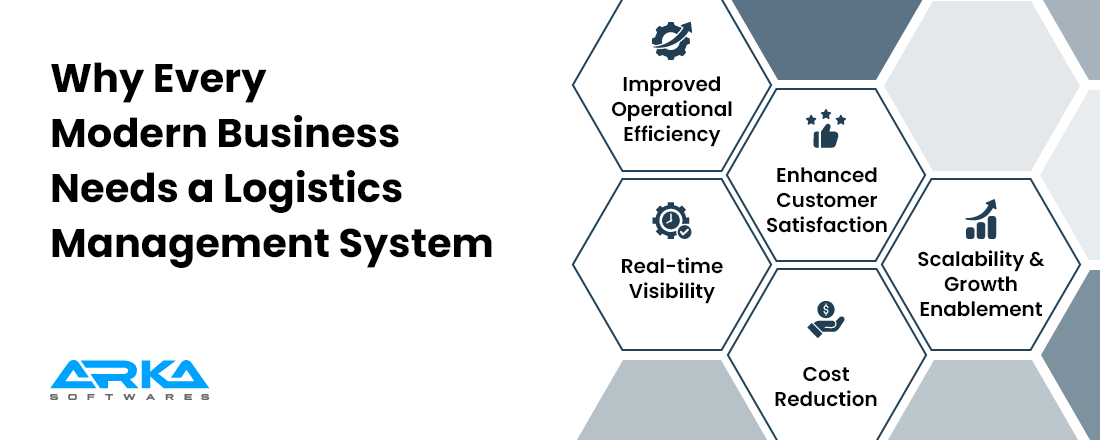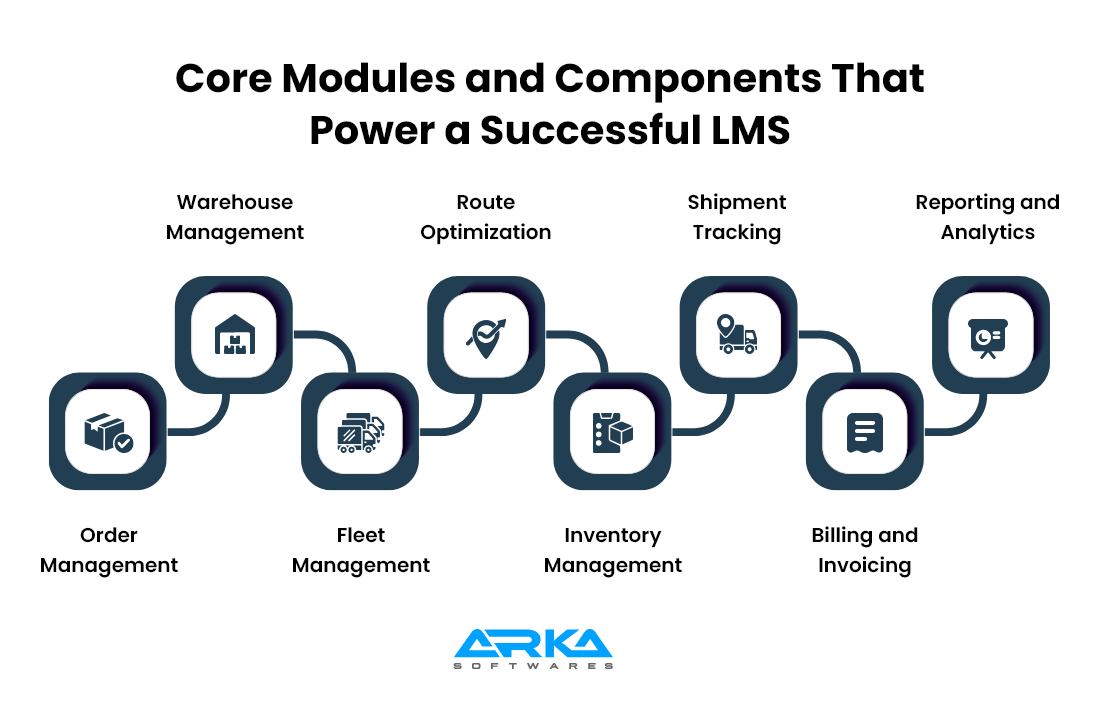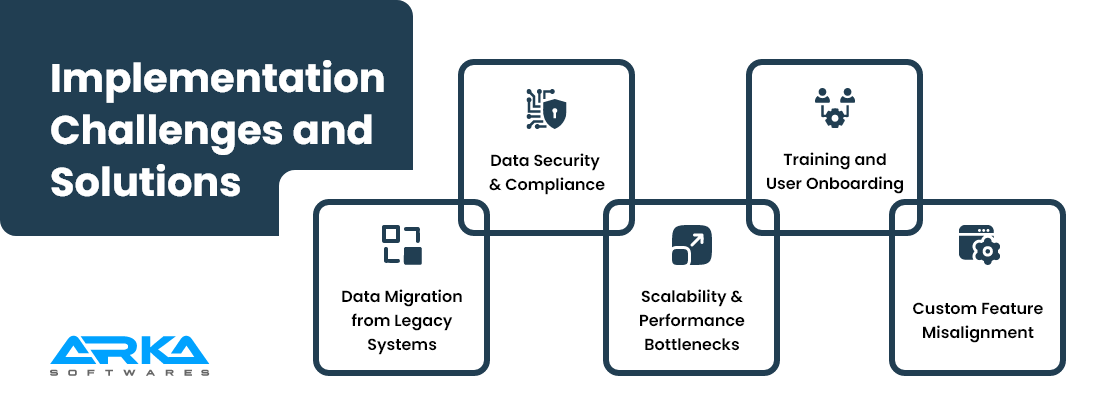Effective supply chain is not a choice anymore, it is a competitive requirement. With companies striving to deliver faster and streamline their operations, there is a growing necessity to develop logistics management system solutions.
An effective logistics management system (LMS) can simplify inventory, automate shipment, and offer real-time supply chain visibility. The market size of logistics management software will grow fast in the coming years. It is expected to reach $19.85 billion in 2029 with a CAGR of 10.2%.
Whether you are a business owner, a tech entrepreneur, or an operations manager, and are interested in knowing how to develop a logistics management system, then this all-around guide will take you through all the necessary steps.
A logistics management system ( LMS ) is a software application that automates and simplifies the flow of goods, services and information through the supply chain.
It assists companies to effectively coordinate major logistics activities involving inventory management, shipping, storage, and order processing through a centralized window. An LMS is important in enhancing operational efficiency and delivery performance by streamlining manual operations and increasing visibility.
Most LMS systems are being integrated with ERP, CRM and accounting systems, thus giving real-time visibility and easy data exchange between departments.
This allows improvement of decision-making, cost saving, and customer service. To succeed in the modern, complex, fast-paced business world, it is crucial to know how to develop shipping and logistics management software, especially when businesses have an interest in scaling or optimization.
Using an efficient logistics management platform enables businesses to automate, scale and optimize their supply chain processes across channels and geographies. Here’s why the decision to develop logistics management system software should be the priority of every modern business.
Manual logistics activities are likely to have delays, redundancy and human error. The logistics management system makes the workflows efficient as the tasks of order processing, inventory tracking, and dispatch planning are automated. This results in shorter turnaround times, minimized errors, and improved inter-departmental coordination, thereby enhancing the overall performance of operations drastically.
When you develop logistics management system tools, one of the most fundamental advantages is end-to-end visibility of the supply chain. Through real-time monitoring of shipments, vehicles, and inventory, the business is able to react swiftly to disturbances, base their decisions on data, and ensure that all stakeholders remain updated.
Customers these days demand quick, precise, and transparent delivery services. Through logistic management software, one can offer real-time delivery reporting, timely delivery, and returns. This increases customer loyalty, decreases complaints and creates a strong reputation in competitive markets.
Without proper management, logistics can run out of control. A smart logistic management software platform assists in finding cost-saving opportunities in the form of route optimization, fuel management, and planning of labor resources. As you build logistics management system tools using analytics, it becomes simpler to identify and remove the cost inefficiencies.
Logistics challenges increase as your business grows. Scalable logistics management system enables growth in business as it manages additional orders, routes and warehousing processes without compromising performance. You have the option to develop logistics management system solutions to your changing needs, ensuring that you scale up competently and sustainably.

An effective logistics management system is based on a series of combined modules that operate in a unified manner to handle all stages of the supply chain. When you develop logistics management system software, you have to incorporate these fundamental elements so that you can have a smooth operation, real-time tracking, and control of the operations.
The order management module is the entry point of logistics. It manages the initiation of orders, their validation, processing and assigning them to the correct fulfillment channels.
The module monitors the status of all orders and connects to inventory and delivery systems, which guarantees the on-time dispatch and completion of the order.
An effective order management solution eliminates the occurrence of manual errors and provides enhancement of service quality at the initial stage of the logistics cycle.
This module manages warehouse operations in terms of receiving, picking, packing, slotting, and dispatching inventory. It monitors the real-time location of items and optimizes space.
Facilities such as barcode/RFID scanning, batch trace, and automatic restocking make the inventory flow smooth.
When you develop logistics management system software that allows high-volume storage and movement efficiently, then you need a robust warehouse management system.
Fleet management is important to the companies that have their own transport units. This module tracks vehicle health, driver performance, fuel consumption and routes of delivery.
It allows scheduling maintenance and minimizes down time or routing delays.
Telematics and GPS tracking can help logistics managers to track fleets on a real-time basis, reduce downtimes, and ensure faster delivery and efficiency.
The route optimization module consists of mapping algorithms and traffic data that proposes the most cost-effective and time-saving delivery routes.
It lowers fuel prices, delivery time, and carbon emissions. Smart systems incorporate AI in logistics management system software to forecast weather problems, propose alternative routing, and optimize delivery weight that will make the route planning more smarter and sustainable.
Demand fulfillment and optimization of stock cannot be done without proper inventory tracking. The module gives real-time inventory status, automated reordering, and the ability to see inventory levels in multiple warehouses or distribution centers.
Combining it with order and warehouse management, companies do not have to overstock or experience stockouts, which is essential when you want to build a logistics management system that can support multichannel operation.
This module provides real-time tracking and status of the shipments during delivery. Customers and stakeholders are able to know the location of a package and the time of its arrival. This transparency creates trust and less support requests.
An effective shipment tracking module also manages exceptions and delay notifications, making the logistics process an effortless experience to both end users and operational personnel.
This module automates financial transactions, including shipping charges, surcharges and taxes. It creates invoices, manages payments, links with ERP and accounting as well as supports multiple currencies.
Billing automation eliminates human error and makes sure that the financial regulations can be adhered to, which is an imperative task for any enterprise willing to develop logistics management system software to operate globally.
Reporting and analytic modules collect data on operations throughout the LMS and transform it into usable information. The dashboards provide insight on delivery performance, fuel consumption, customer satisfaction and inventory turnover.
Predictive analytics can be used to make forecasts about demand, resource optimization, and better future planning based on machine learning in a logistics management information system.

To develop logistics management system software that is scalable, intelligent, and future-ready, it should incorporate a range of modern and impactful features.
Such functionalities do not only automate redundant tasks, but also enhance visibility, decision-making, and collaboration within the logistics network.
This functionality enables the logistics companies to serve numerous clients or business units through one platform. It isolates data, processes, and accessibility of every client in a secure manner, making it scalable and controllable.
The multi-client architecture is essential to 3PL companies or businesses wishing to build custom logistics management system solutions that can manage multiple supply chains at once.
GPS tracking of vehicles, shipments and assets in real-time helps businesses to track the location and status of the delivery. It enhances the accuracy of the delivery, security, and assists in proactively responding to delays or disruptions.
When you create logistic management system tools aimed at transparency and customer satisfaction, real-time visibility is a necessity.
With mobile support, logistics managers, drivers, and warehouse personnel can access important information when they are on the move. Mobile applications make it possible to scan, update tasks, navigate routes, and communicate instantly.
For any affordable logistic management system, mobile access is a cost-effective solution to enhance efficiency in distributed teams and remote operations.
This aspect manages access to system modules depending on the user roles, i.e., admin, manager, dispatcher, or driver. It enhances data security, limits human error, and makes sure that employees access only the information they need due to their specific responsibilities.
When you develop logistics management system software, proper user access control is necessary to avoid data breaches and control operations.
The modern logistics management system should be connected with the third-party platforms such as ERP, CRM, accounting, and eCommerce solutions. API-led integration minimizes the number of data silos and simplifies cross-system workflows.
The ability to integrate is essential in deriving the most out of logistics management system software, particularly in multi-system, complex environments.
Artificial intelligence can be used to forecast the future demand using past sales, seasonal trends, and market behavior. This assists businesses to ensure that they optimize their stock levels, as well as eliminate overstocking or shortages.
Using AI to create logistic management system improves logistic resource and inventory planning to make smarter decisions in the supply chain.
Smart sensors, RFID and GPS devices can provide your logistic management software with real-time data. This allows tracking temperature sensitive products, asset usage, and machine efficiency in the warehouse.
With IoT integration, logistics operations are no longer reactive but proactive, which allows carrying out predictive maintenance and managing assets in real-time.
Blockchain technology guarantees tamper-proof records of every logistics transaction and transport. It is especially useful in international shipments, where several parties are involved.
Blockchain implementation offers improved trust, fraud protection, and better audit trails, which is a critical requirement when you develop a logistics management system.
Pattern recognition and data-driven decision-making are possible with machine learning in logistic system development. It is able to figure out the best delivery schedules, routes and warehouse layouts using previous data.
This leads to the constant enhancement of performance and intelligent automation, which saves money on operations and delivery in the long-term.
Automated reporting enables companies to create performance reports, summary financials, and operation dashboards without manual work. Decision-making with customizable reports will provide insights on key performance indicators such as delivery times, the accuracy of orders and fleet efficiency.
This functionality saves time and guarantees that every stakeholder can receive timely and correct information.

Developing an effective and scalable logistics management software is not all about coding. Regardless of whether you are creating an in-house solution or collaborating with a professional company, use this roadmap to develop logistics management system software from start to end.
This is the first step where you determine the precise requirements of your business and the end-users. It involves learning the logistics processes, the expectations of stakeholders, regulatory conditions, and pain points.
A comprehensive requirement document assists in ensuring that you build custom logistics management system tools that are specific to your respective challenges and objectives.
Go through already available logistics management system software in the market. Compare their features, user experience, pricing models and customer testimonials. Knowledge of competitor strengths and weaknesses assists in creating unique value propositions and prevents pitfalls when you proceed to develop logistics management system platforms.
Make a prioritized list of features beginning with MVP (Minimum Viable Product) functionalities. Create wireframes and mockups that will give visual representation of the user interface and experience.
Good design maintains usability, minimizing resistance by the user. This is a very important step in bridging the gap between technical capabilities and business goals before you start your way to developing logistic management solution software.
Choose the best technical team that can make your vision come true. You may hire dedicated developer teams or collaborate with a local agency.
Seek providers with a track record in logistic management software to be sure of their expertise in the field and success of the project.
This is where coding starts. Backend developers create the logic of the system, the API, and the connection to the database, and frontend developers focus on the interface and user experience. Mobile apps and dashboards are also designed during this phase when they are required.
The most appropriate methodology to use during this phase is agile, which allows constant feedback and improvement as you build logistics management system components.
The software is tested thoroughly in terms of functionality, usability, performance, security and integration before it is deployed. Automatic and manual testing makes the software error-free and stable.
An effective QA process will guarantee that your logistics management system is fit to the user expectations and regulatory standards without any post-launch problems that can be quite expensive to solve.
Once tested successfully, the system is put into a live environment. It may be on-premise or on the cloud, such as AWS or Azure.
Deployment also involves setting up real-time databases, linking IoT devices and third-party tools integration. This is where the real action starts with your logistic management software.
It does not end with launching the system, follow-ups are necessary. This involves bug fixing, user training, feedback gathering and release of feature upgrades.
The post-launch support will enable you to sustain performance, enhance user adoption and control the software maintenance cost effectively.
| Component | Recommended Technologies |
|---|---|
| Frontend (UI/UX) | React.js, Angular, Vue.js |
| Backend | Node.js, Django (Python), Laravel (PHP), Spring Boot (Java) |
| Database | PostgreSQL, MySQL, MongoDB |
| Cloud Hosting | AWS, Microsoft Azure, Google Cloud |
| AI/ML Capabilities | TensorFlow, PyTorch, Scikit-learn, OpenAI APIs |
| IoT Integration | AWS IoT Core, Azure IoT Hub, Arduino, Raspberry Pi |
| DevOps / CI-CD | Jenkins, GitHub Actions, Docker, Kubernetes |
| API & Integration Layer | REST, GraphQL, gRPC, Swagger |
The cost to develop logistic management system software is essential in budgeting and project planning. The costs may differ considerably depending on features, development method and the geographical location of your development team.
This entry-level system has the basic modules such as order management, basic tracking of inventory and the shipment schedules. It is best suited to startups or small logistic companies which require an affordable logistic management system with minimal customization.
The development can typically take 2-3 months and can potentially lack mobile applications, or third party integrations to ensure costs are as low as possible.
Mid-tier systems will incorporate sophisticated modules such as route optimization, mobile accessibility, real-time tracking and linking with other external tools such as ERP or CRM.
This level is usually suitable for growing businesses, where the company partners with offshore software development services to reduce development costs without compromising quality.
The timeline of the projects is 4-6 months.
These solutions are designed to operate at a large scale and feature AI-driven analytics, IoT devices integration, machine learning in logistic systems planning, blockchain capabilities, and a multi-client architecture.
Enterprise solutions are likely to be highly customized with a need of continuous support.
The logistics management system price offers scalability, data security, and compliance, with the development time ranging between 6 to 12 months or even longer.

Effective implementation of a plan to develop logistics management system software does not conclude with design and development. Implementation has its own real-world issues that may impede adoption and performance unless addressed effectively.
Data migration from the old systems may be complex and prone to errors, in case of varying formats or incomplete records.
Without proper management, businesses can lose or corrupt the data. The solution is to build robust data mapping and data validation mechanisms, apply ETL (Extract, Transform, Load) tools, and engage in testing prior to going live.
Sensitive data like customer information, payment details and route information are managed by a logistics management system.
Poor security may result in security breaches or failure to comply with industry rules. To prevent cyber threats, you can use powerful encryption, multi-factor authentication, and role-based access.
Systems that are not scalable can slow down or crash as operations increase. Lack of scalability limits the growth and effectiveness of a business.
The solution is to design with scalable cloud infrastructure, microservices architecture and performance monitoring tools, particularly relevant when you are developing logistic management solution platforms for high volume operations.
Users might not be able to get around the system or utilize the main features without appropriate training. This affects productivity and ROI. Custom software development services are able to build interactive onboarding programs, detailed user manuals and offer support.
The user-centric training method will help to make the system adopted efficiently and used to the fullest extent.
Sometimes businesses attempt to build logistics management system tools with overly complex or mismatched features that don’t align with operational needs. This leads to poor usability and increased cost to develop logistic management system.
Avoid this by conducting thorough requirements analysis, involving end users in feature planning, and building iteratively with regular feedback loops.

You should focus on the proper strategy, technology, and implementation to develop logistics management system software that will provide ROI and fulfill the needs of modern businesses.
Partnering with a professional logistic software development company will greatly reduce your time-to-market and expenditure.
Ultimately, logistics management system development is an essential move to operational excellence and digital transformation.
Typically 3–12 months, depending on features, complexity, and development team size.
Retail, eCommerce, manufacturing, 3PL, healthcare, and food industries benefit the most.
Yes, you can build custom logistics management system software that includes features aligned with your unique workflow.
Yes, machine learning in logistic system operations enables predictive maintenance, demand forecasting, route optimization, and anomaly detection.